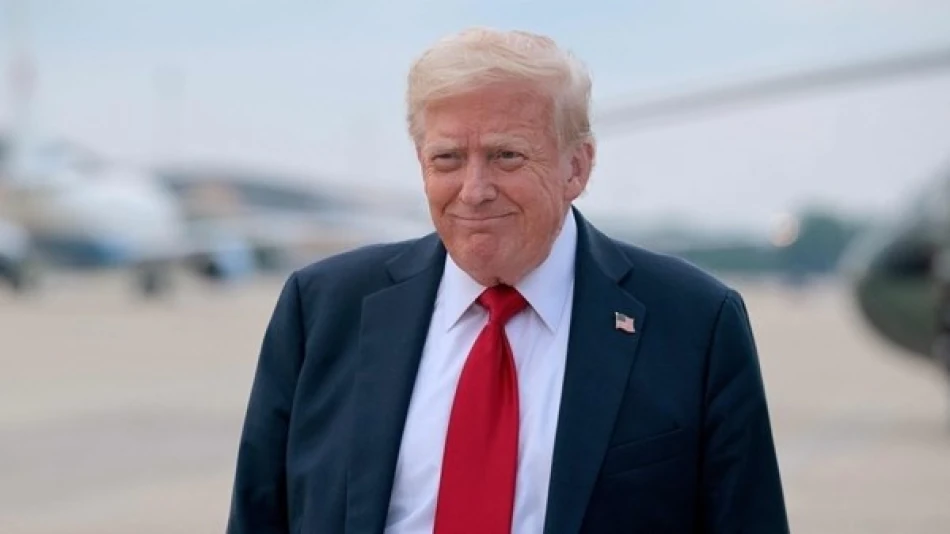
Trump Pledges to Reduce Tariffs on Countries that Open Their Markets
Trump's Tariff Diplomacy Bears Fruit as Indonesia Opens Market Access in Strategic Trade Deal
President Donald Trump has secured a bilateral trade agreement with Indonesia that grants American producers significant access to Southeast Asia's largest economy, demonstrating how his administration's tariff threats are translating into concrete market openings. The deal, announced alongside similar agreements with the Philippines and Japan, represents a major breakthrough for U.S. manufacturing, agriculture, and digital technology sectors seeking expansion in the world's fourth most populous nation.
The Carrot-and-Stick Strategy Takes Shape
Trump outlined his trade philosophy on Truth Social, emphasizing that tariff reductions will only come when major economies reciprocate by opening their markets to American goods. "I will always give up tariffs if I can get major countries to open their markets to the United States of America," Trump wrote, adding that tariffs remain his primary leverage tool for forcing market access negotiations.
This approach marks a departure from traditional multilateral trade frameworks, instead favoring bilateral deals that Trump argues deliver more tangible benefits for American exporters. The strategy appears designed to create immediate wins while maintaining pressure on trading partners through the threat of escalating tariffs.
Indonesia Deal: A Gateway to Southeast Asia
Market Access Terms
Under the new agreement, Indonesian products exported to the United States will face a 19% tariff rate, while American companies gain enhanced access to Indonesia's 275 million-person market. The deal specifically targets the removal of tariff barriers and reduction of non-tariff obstacles that have historically limited U.S. industrial and agricultural exports to the archipelago nation.
Strategic Significance
Indonesia represents a particularly valuable prize for American businesses. As Southeast Asia's largest economy and a member of the G20, Indonesia has traditionally maintained protective trade policies that favored domestic industries and regional partners. The agreement potentially opens sectors including technology services, agricultural products, and manufacturing equipment where U.S. companies have competitive advantages but faced market access barriers.
The timing is also significant as Indonesia continues its rapid economic development and infrastructure expansion, creating demand for the high-value industrial and technology products where American firms excel.
Broader Trade Momentum
The Indonesia agreement comes as part of a broader diplomatic push, with Trump announcing similar deals with the Philippines and Japan on the same day. This coordinated approach suggests the administration is leveraging its tariff authority to secure multiple market openings simultaneously, potentially creating momentum for additional agreements with other Asia-Pacific economies.
Market and Investor Implications
For American exporters, particularly in agriculture and manufacturing, these agreements could translate into substantial revenue opportunities. Indonesia's growing middle class and infrastructure needs align well with U.S. strengths in advanced manufacturing, agricultural technology, and digital services.
The 19% tariff rate on Indonesian exports to the U.S. also creates a competitive advantage for American producers in sectors where Indonesian companies previously competed on price alone. This could particularly benefit U.S. textile, electronics, and consumer goods manufacturers.
However, the bilateral approach may create complexity for multinational corporations operating across multiple markets, as they navigate varying tariff rates and market access conditions depending on each country's agreement status with the United States.
Regional Trade Dynamics
Trump's bilateral strategy contrasts sharply with the multilateral Regional Comprehensive Economic Partnership (RCEP) that includes Indonesia and other Asian economies. By offering preferential access to the U.S. market in exchange for reciprocal treatment, the administration is effectively competing with China's influence in regional trade arrangements.
This approach could encourage other Southeast Asian nations to pursue similar bilateral agreements with the United States rather than relying solely on regional frameworks where China plays a dominant role. The success of the Indonesia model may accelerate negotiations with Vietnam, Thailand, and Malaysia, all of whom have significant trade relationships with the United States.
Most Viewed News

 Layla Al Mansoori
Layla Al Mansoori






